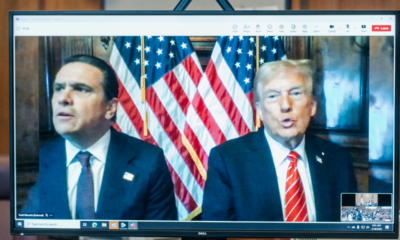Health
Tommy John surgery continues to save baseball careers 50 years after its debut: 'Revolutionary'

It’s been nearly 50 years since one of the biggest advancements in sports medicine: Tommy John surgery.
On Sept. 25, 1974, Dr. Frank Jobe first performed the operation on Tommy John, a professional baseball pitcher who played on Major League Baseball (MLB) teams between 1963 and 1989.
During the surgery, Jobe reconstructed a torn ulnar collateral ligament (UCL) in John’s left arm.
ON THIS DAY IN HISTORY, MARCH 7, 1857, BASEBALL ADOPTS NINE PLAYERS, NINE INNINGS AS STANDARD OF COMPETITION
It was a pioneering achievement for Jobe and a lifeline for John, who went from a career-ending injury to 14 more years in the majors — and an eponymous connection to sports medicine that would live on long past his playing days.
Since then, Tommy John surgery — more formally known as ulnar collateral ligament (UCL) reconstruction, according to Johns Hopkins Medicine — has been performed on many other baseball players.
New York Yankees pitcher Tommy John delivering a pitch versus the Kansas City Royals during a game at Yankee Stadium on July 9, 1988, in New York. (Getty Images)
Those players include David Wells (1985), John Smoltz (2000), Stephen Strasburg (2010), Rich Hill (2011), Shohei Ohtani (2018), Justin Verlander (2020) and Bryce Harper (2022), to name a few, according to MLB.
“I wouldn’t still be standing here if it weren’t for a surgery like this,” Chicago White Sox pitcher Michael Kopech said, according to the Associated Press. “It’s doubled the length of my career.”
ON THIS DAY IN HISTORY, JANUARY 31, 1919, JACKIE ROBINSON IS BORN IN GEORGIA — BASEBALL PIONEER, WWII VETERAN
John Gallucci, a New Jersey-based physical therapist specializing in sports injuries, noted that Tommy John surgery has prolonged and saved many careers.
“Before this surgery, a torn UCL was considered a career-ending injury,” he told Fox News Digital.
“This surgery was a major advancement in treatment and was revolutionary for athletes and those who suffer from elbow injuries.”

Dr. Frank Jobe, orthopedic surgeon and Los Angeles Dodgers team physician, pioneered elbow ligament replacement and shoulder surgery for baseball players, a procedure commonly known today as Tommy John surgery. Jobe is pictured here in 1997. (Getty Images)
Alongside arthroscopic surgery and ACL reconstruction, Tommy John surgery is one of the biggest advancements in sports medicine in the last 50 years, according to Dr. Tim Kremchek, a longtime physician for the Cincinnati Reds.
“It [has] just prolonged and saved so many careers,” he said to the AP.
“Not just in baseball, but now for some other sports that we’re doing it for — so many other athletes, especially overhead athletes. But in terms of baseball, I think it’s allowed us to see some of the greatest players in the world continue to play for a long period of time.”
“It’s allowed us to see some of the greatest players in the world continue to play for a long period of time.”
In the debut operation at Rancho Los Amigos, a Southern California hospital, Jobe removed the palmaris longus tendon from John’s right arm, drilled four holes in his left elbow — and then used the tendon to replace the torn ligament.
“It wasn’t a new idea,” Jobe said in July 2013, about seven months before he died.
“It was just new for the elbow.”

In the first procedure, Jobe removed the palmaris longus tendon from John’s right arm, drilled four holes in his left elbow, and then used the tendon to replace the torn ligament (not pictured). (iStock)
The procedure itself hasn’t changed much since Jobe pioneered it, though doctors have made a few improvements.
“It has remained primarily the same, but advancements have been made,” said Gallucci.
“These advancements have made the surgery even more effective in tandem with work from physical therapists and certified athletic trainers during the recovery process.”
BASEBALL QUIZ! HOW WELL DO YOU KNOW THE POPULAR AMERICAN SPORT?
“Due to the advancements made and the rehabilitation process improvements, the standard recovery period has been cut nearly in half from what it was 50 years ago,” he added.
The effects of Tommy John surgery have been seen in players’ performance on the field.
Verlander won the AL Cy Young Award in 2022, two years after he had Tommy John surgery.

Tommy John of the New York Yankees is pictured prior to the start of a Major League Baseball game circa 1987 at Yankee Stadium in the Bronx, New York. (Getty Images)
Harper, who had the procedure in Nov. 2022, returned to Philadelphia’s lineup in May.
Dodgers pitcher Tyler Glasnow, who had Tommy John in 2021, struck out 162 batters in a career-high 120 innings last year.
Within months of receiving his second major elbow operation, Ohtani landed a record-breaking $700 million contract from the Los Angeles Dodgers.
“There’s no question that Tommy John is the most valuable reconstructive procedure there is.”
“If you put it in dollars and cents, I think there’s no question that Tommy John is the most valuable reconstructive procedure there is,” Dr. Neal ElAttrache, the head team physician for the Dodgers and the NFL’s Los Angeles Rams, told the AP.
Despite its high success rate, the main challenge associated with the surgery has been the extended recovery and rehabilitation process.
For about 10 days after the surgery, the patient must wear a cast at a 90-degree angle.

“It wasn’t a new idea,” Jobe said in July 2013, about seven months before he died. “It was just new for the elbow.” (Getty Images)
It then takes months for the player to regain a full range of motion, and usually at least a year before returning to the field.
“Although this surgery was revolutionary, the road to recovery is no easy process — and that is where physical therapy comes into play,” said Gallucci, who has seen patients throughout the years in rehab from Tommy John surgery.
CLICK HERE TO SIGN UP FOR OUR HEALTH NEWSLETTER
“It requires commitment from the patient, as it is no easy feat,” he said.
“Although it takes a few months of rehab and slowly increasing strengthening exercises, I have seen patients make a full recovery and be able to play again.”
Dodgers pitcher Tony Gonsolin, who had surgery on Sept. 1, recalled his first day of throwing after the operation.

Tommy John, the 4-time All Star pitcher who won 288 games, is pictured at right with Tommy John III, a chiropractor in sports medicine. (Getty Images)
“It was like 30 throws, nice and easy, and just felt super foreign, like I’d never thrown before,” he said, as the AP reported. “Took some video on it, and they did not look pretty at all. Then I threw a couple [of] days later and it felt much better.”
Approaching the 50th anniversary of the surgery, Gonsolin said he is grateful for the medical advancement that started with Tommy John in 1974.
“I think the evolution of the surgery and just the sheer medical breakthrough from it allows [it] to extend people’s careers,” he said.
“It gives everybody a second opportunity.”
The Associated Press contributed to this report.
For more Health articles, visit www.foxnews.com/health.

Health
Cancer Remission Like Catherine’s Does Not Always Mean the Illness Is Cured

Princess Catherine, wife of Prince William, reported on Tuesday that her cancer was in remission. But what does it mean to be in remission from cancer?
Doctors discovered her cancer unexpectedly last March when she had abdominal surgery. She has not revealed the type of cancer she has, nor how advanced it was when it was discovered.
But she did say she had chemotherapy, which she said had been completed in September. She told the British news agency PA Media that she had a port, a small device that is implanted under the skin and attached to a catheter that goes into a large vein. It allows medicines like chemotherapy drugs to be delivered directly to veins in the chest, avoiding needle sticks.
Catherine told PA Media that chemotherapy was “really tough.”
“It is a relief to now be in remission and I remain focused on recovery,” she wrote on Instagram.
Her announcement “certainly is good news and is reassuring,” said Dr. Kimmie Ng, associate chief of the division of gastrointestinal oncology at the Dana-Farber Cancer Institute in Boston.
But cancer experts like Dr. Ng say that the meaning of remission in a patient can vary.
In general, when doctors and patients talk about remission, they mean there is no evidence of cancer in blood tests or scans.
The problem is that a complete remission does not mean the cancer is gone. Even when a cancer is “cured” — defined as no evidence of cancer for five years — it may not be vanquished.
That makes life emotionally difficult for patients, who have to have frequent visits with oncologists for physical exams, blood tests and imaging.
“It’s really scary,” Dr. Ng said. “The amount of uncertainty is very very hard,” she added.
But that ongoing surveillance is necessary, despite the toll it takes on patients.
“Different cancers have different propensities of returning or not returning,” said Dr. Elena Ratner, a gynecologic oncologist at the Yale Cancer Center.
As many as 75 to 80 percent of ovarian cancers, she noted, can come back in an average of 14 to 16 months after a remission, depending on the stage the cancer had reached when it was found and on the cancer’s biology.
“Once the cancer returns, it becomes a chronic disease,” Dr. Ratner said. She tells her patients: “You will live with this cancer. You will be on and off chemotherapy for the rest of your life.”
Dr. Ratner’s gynecological cancer patients have to come back every three months for CT scans to keep an eye out for evidence that the cancer has returned.
“The women live CT scan to CT scan,” she said. “They say that for two and a half months, they have a wonderful life, but then, in time for the next CT scan, the fear returns.”
“It costs them — it costs them a lot,” she said.
“It’s awful, yet I am amazed every day by their strength,” she said of her patients.
Health
Death Toll in Gaza Likely 40 Percent Higher Than Reported, Researchers Say

Deaths from bombs and other traumatic injuries during the first nine months of the war in Gaza may have been underestimated by more than 40 percent, according to a new analysis published in The Lancet.
The peer-reviewed statistical analysis, led by epidemiologists at the London School of Hygiene and Tropical Medicine, used modeling in an effort to provide an objective third-party estimate of casualties. The United Nations has relied on the figure from the Hamas-led Ministry of Health, which it says has been largely accurate, but which Israel criticizes as inflated.
But the new analysis suggests the Hamas health ministry tally is a significant undercount. The researchers concluded that the death toll from Israel’s aerial bombardment and military ground operation in Gaza between October 2023 and the end of June 2024 was about 64,300, rather than the 37,900 reported by the Palestinian Ministry of Health.
The estimate in the analysis corresponds to 2.9 percent of Gaza’s prewar population having been killed by traumatic injury, or one in 35 inhabitants. The analysis did not account for other war-related casualties such as deaths from malnutrition, water-borne illness or the breakdown of the health system as the conflict progressed.
The study found that 59 percent of the dead were women, children and people over the age of 65. It did not establish what share of the reported dead were combatants.
Mike Spagat, an expert on calculating casualties of war who was not involved in this research, said the new analysis convinced him that Gaza casualties were underestimated.
“This is a good piece of evidence that the real number is higher, probably substantially higher, than the Ministry of Health’s official numbers, higher than I had been thinking over the last few months,” said Dr. Spagat, who is a professor at Royal Holloway College at the University of London.
But the presentation of precise figures, such as a 41 percent underreported mortality, is less useful, he said, since the analysis actually shows the real total could be less than, or substantially more. “Quantitatively, it’s a lot more uncertain than I think comes out in the paper,” Dr. Spagat said.
The researchers said their estimate of 64,260 deaths from traumatic injury has a “confidence interval” between 55,298 and 78,525, which means the actual number of casualties is likely in that range.
If the estimated level of underreporting of deaths through June 2024 is extrapolated out to October 2024, the total Gazan casualty figure in the first year of the war would exceed 70,000.
“There is an importance to war injury deaths, because it speaks to the question of whether the campaign is proportional, whether it is, in fact, the case that sufficient provisions are made to to avoid civilian casualties,” said Francesco Checchi, an epidemiologist with an expertise in conflict and humanitarian crises and a professor at the London School of Hygiene and Tropical Medicine who was an author on the study. “I do think memorializing is important. There is inherent value in just trying to come up with the right number.”
The analysis uses a statistical method called capture-recapture analysis, which has been used to estimate casualties in other conflicts, including civil wars in Colombia and Sudan.
For Gaza, the researchers drew on three lists: The first is a register maintained by the Palestinian Ministry of Health, which mainly comprises the dead in hospital morgues and estimates of the number of unrecovered people buried in rubble. The second is deaths reported by family or community members through an online survey form the ministry established on Jan. 1, 2024, when the prewar death registration system had broken down. It asked Palestinians inside and outside Gaza to provide names, ages, national ID number and location of death for casualties. The third source was obituaries of people who died from injuries that were published on social media, which may not include all of the same biographical details and which the researchers compiled by hand.
The researchers analyzed these sources to look for individuals who appear on multiple lists of those killed. A high level of overlap would have suggested that few deaths were uncounted; the low amount they found suggested the opposite. The researchers used models to calculate the probability of each individual appearing on any of the three lists.
“Models enable us to actually estimate the number of people who have not been listed at all,” Dr. Checchi said. That, combined with the listed number, gave the analysts their total.
Patrick Ball, director of research at the Human Rights Data Analysis Group, and a statistician who has conducted similar estimates of violent deaths in conflicts in other regions, said the study was strong and well reasoned. But he cautioned that the authors may have underestimated the amount of uncertainty caused by the ongoing conflict.
The authors used different variations of mathematical models in their calculations, but Dr. Ball said that rather than presenting a single figure — 64,260 deaths — as the estimate, it may have been more appropriate to present the number of deaths as a range from 47,457 to 88,332 deaths, a span that encompasses all of the estimates produced by modeling the overlap among the three lists.
“It’s really hard to do this kind of thing in the middle of a conflict,” Dr. Ball said. “It takes time, and it takes access. I think you could say the range is larger, and that would be plausible.”
While Gaza had a strong death registration process before the war, it now has only limited function after the destruction of much of the health system. Deaths are uncounted when whole families are killed simultaneously, leaving no one to report, or when an unknown number of people die in the collapse of a large building; Gazans are increasingly buried near their homes without passing through a morgue, Dr. Checchi said.
The authors of the study acknowledged that some of those assumed dead may in fact be missing, most likely taken as prisoners in Israel.
Roni Caryn Rabin and Lauren Leatherby contributed reporting.
Health
Dementia risk for people 55 and older has doubled, new study finds

Dementia cases in the U.S. are expected to double by 2060, with an estimated one million people diagnosed per year, according to a new study led by Johns Hopkins University and other institutions.
Researchers found that Americans’ risk of developing dementia after age 55 is 42%, double the risk that has been identified in prior studies, a press release stated.
For those who reach 75 years of age, the lifetime risk exceeds 50%, the study found.
AGING ‘HOTSPOT’ FOUND IN BRAIN, RESEARCHERS SAY: ‘MAJOR CHANGES’
Women face a 48% average risk and men have a 35% risk, with the discrepancy attributed to women living longer than men.
Dementia cases in the U.S. are expected to double by 2060, with an estimated one million people diagnosed per year. (iStock)
The study, which was published in the journal Nature Medicine on Jan. 13, analyzed data from the Atherosclerosis Risk in Communities Neurocognitive Study (ARIC-NCS), which has tracked the cognitive and vascular health of nearly 16,000 adults since 1987.
DEEP SLEEP CAN KEEP TWO BIG HEALTH PROBLEMS AT BAY, NEW STUDIES SUGGEST
“Our study results forecast a dramatic rise in the burden from dementia in the United States over the coming decades, with one in two Americans expected to experience cognitive difficulties after age 55,” said study senior investigator and epidemiologist Josef Coresh, MD, PhD, who serves as the founding director of the Optimal Aging Institute at NYU Langone, in the release.
Understanding risk factors
“One of the main reasons for the increase is that great medicine and tecnological advances are keeping us alive longer and age is a risk factor for dementia,” Dr. Marc Siegel, clinical professor of medicine at NYU Langone Health and Fox News senior medical analyst, told Fox News Digital.
“Obesity is associated with inflammation, diabetes and high blood pressure, which are all independent risk factors for dementia.”
In addition to aging, other risk factors include genetics, obesity, hypertension, diabetes, unhealthy diets of ultraprocessed foods, sedentary lifestyles and mental health disorders, the release said.
“We have an obesity epidemic with over 45% adults obese in the U.S.,” Siegel noted. “Obesity is associated with inflammation, diabetes and high blood pressure, which are all independent risk factors for dementia.”
“And as an unhealthy population, we also have more heart disease, and atrial fibrillation is a risk factor for cognitive decline,” he added.
Dementia risk was found to be higher among people who have a variant of the APOE4 gene, which has been linked to late-onset Alzheimer’s disease. Black adults also have a higher risk.

Researchers found that Americans’ risk of developing dementia after age 55 is 42%, double the risk that has been identified in prior studies. (iStock)
Research has shown that the same interventions used to prevent heart disease risk could also prevent or slow down dementia, the study suggested.
“The pending population boom in dementia cases poses significant challenges for health policymakers in particular, who must refocus their efforts on strategies to minimize the severity of dementia cases, as well as plans to provide more health care services for those with dementia,” said Coresh.
CLICK HERE TO SIGN UP FOR OUR HEALTH NEWSLETTER
What needs to change?
Professor Adrian Owen, PhD, neuroscientist and chief scientific officer at Creyos, a Canada-based company that specializes in cognitive assessment and brain health, referred to the increase in dementia cases as a “tidal wave.”
“This new study’s anticipated surge in dementia cases underscores the urgent need for early and accurate detection,” he told Fox News Digital.
“By catching issues early, we give people the power to make lifestyle adjustments, seek available treatments and plan their futures with clarity.”
“By identifying cognitive decline at its earliest stages, we have an opportunity to intervene before patients and families bear the full weight of the disease.”
Owen recommends conducting regular cognitive assessments as part of routine check-ups to proactively identify early signs of cognitive decline.
“By catching issues early, we give people the power to make lifestyle adjustments, seek available treatments and plan their futures with clarity,” he said.

“By identifying cognitive decline at its earliest stages, we have an opportunity to intervene before patients and families bear the full weight of the disease.” (iStock)
Maria C. Carrillo, PhD, chief science officer and medical affairs lead for the Alzheimer’s Association in Chicago, said there is an “urgent need” to address the global crisis of Alzheimer’s disease and dementia.
To help keep the aging brain healthy, the Alzheimer’s Association published its report 10 Healthy Habits for Your Brain. Some of the tips are listed below.
For more Health articles, visit www.foxnews.com/health
– Participate in regular physical activity.
– Learn new things throughout your life and engage your brain.
– Get proper nutrition — prioritize vegetables and leaner meats/proteins, along with foods that are less processed and lower in fat.
– Avoid head injury (protect your head).
– Have a healthy heart and cardiovascular system — control blood pressure, avoid diabetes or treat it if you have it, manage your weight and don’t smoke.

Research has shown that the same interventions used to prevent heart disease risk could also prevent or slow down dementia. (iStock)
The research was funded by the National Institutes of Health.
Fox News Digital reached out to the researchers for additional comment.
-

 Health1 week ago
Health1 week agoOzempic ‘microdosing’ is the new weight-loss trend: Should you try it?
-
/cdn.vox-cdn.com/uploads/chorus_asset/file/25822586/STK169_ZUCKERBERG_MAGA_STKS491_CVIRGINIA_A.jpg)
/cdn.vox-cdn.com/uploads/chorus_asset/file/25822586/STK169_ZUCKERBERG_MAGA_STKS491_CVIRGINIA_A.jpg) Technology6 days ago
Technology6 days agoMeta is highlighting a splintering global approach to online speech
-

 Science4 days ago
Science4 days agoMetro will offer free rides in L.A. through Sunday due to fires
-
/cdn.vox-cdn.com/uploads/chorus_asset/file/25821992/videoframe_720397.png)
/cdn.vox-cdn.com/uploads/chorus_asset/file/25821992/videoframe_720397.png) Technology1 week ago
Technology1 week agoLas Vegas police release ChatGPT logs from the suspect in the Cybertruck explosion
-

 Movie Reviews1 week ago
Movie Reviews1 week ago‘How to Make Millions Before Grandma Dies’ Review: Thai Oscar Entry Is a Disarmingly Sentimental Tear-Jerker
-

 Health1 week ago
Health1 week agoMichael J. Fox honored with Presidential Medal of Freedom for Parkinson’s research efforts
-

 Movie Reviews1 week ago
Movie Reviews1 week agoMovie Review: Millennials try to buy-in or opt-out of the “American Meltdown”
-

 News1 week ago
News1 week agoPhotos: Pacific Palisades Wildfire Engulfs Homes in an L.A. Neighborhood

















